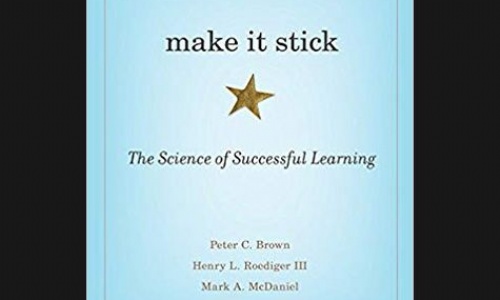MAKE IT STICK, THE SCIENCE OF SUCCESSFUL LEARNING

Summary by Kathryn Pipe
The book begins by agreeing the following the points with readers:
Learning requires memory
We need to keep learning and remembering throughout our lives
Learning is an acquired skill (the book sets out to persuade that this point is true)
This book details strategies to support increased learning and longer retention of learning – giving research and details to support. The book has eight chapters which are as follows: learning is misunderstood; to learn retrieve; mix up your practice; embrace difficulties; avoid illusions of knowing; get beyond learning styles; increase your abilities; make it stick. It is littered with detailed research examples and science.
Practical Strategies recommended which could be used in the classroom include:
- Interleaving and varied practice “interleave the practice of two or more subjects, retrieval is harder and feels less productive, but the effort produces longer lasting learning and enables more versatile applications”
- Mastery requires both the possession of ready knowledge and the conceptual understanding of how to use it
- Power of low-stakes testing, dynamic testing (focusing the learner and teacher on areas that need to be brought up) combined with feedback (some evidence that delaying the feedback produces better long term memory)
- Retrieval practice with cognitive effort “repeated retrieval strengthens memory”
- Importance of time for consolidation
- Importance of effort and challenge
- Embrace difficulties and failure. Quote from Thomas Edison “I’ve not failed, I’ve just found 10,000 ways that didn’t work”
- The impact of memory (interestingly not all positive!)
- Learning from peers/peer review
- Self-belief and own perceptions
- Exercises that wrestle with finding solutions
- Emphasises throughout the need to mix up teaching to support long term learning “space your testing, vary your practice, keep the long view”
- Use of drawing and visualising AND MUCH MORE….
Information is detailed about work completed in 2008 by Pashler, McDaniel, Rohrer, Bjork to determine views of learning styles – summary of their findings: “they found that none validate it and several flatly contradict it…their review showed that it is more important that the mode of instruction match the nature of the subject begin taught.” There is much interesting material about intelligence, culminating in Robert Sternberg’s three-part theory of successful intelligence: analytical intelligence, creative intelligence and practical intelligence. The brain is discussed “the brain’s enduring mutability” over the penultimate chapter with controversial theories explored. The book ends with tips for learners, life-long learners and teachers. Be transparent with learners – teaching what a learner does, can do and needs to do from the outset.
What I will use –
- Confidence to include more low stakes testing,
- It helped me to understand better the importance of, and difference between, knowledge and conceptual understanding, and how this supports mastery.
- More to think about regarding worked examples verses problems to struggle with.
